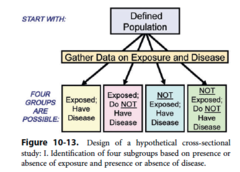Chapter 12: Epidemiology – Flashcards
Unlock all answers in this set
Unlock answersquestion
health
answer
health, which is a state of complete physical, mental and social wellbeing, and not merely the absence of disease or infirmity, is a fundamental human right and the attainment of the highest possible level of health is the most important social goal
question
Public health
answer
a system and social enterprise; a profession; a collection of methods, knowledge, and techniques; governmental health services, especially medical care for the poor and underserved; and the health status of the public
question
the mission of public health
answer
to fulfill "society's interest in assuring conditions in which people can be healthy" indicating a societal interest in the health of all its members but cautioned that this broad view of health and the role of public health professionals and agencies forces practitioners to make difficult choices about where to focus their energies and raises the possibility that such a broad definition could lose distinctive meaning.
question
Epidemiology
answer
the study of the occurrence and distribution of health-related states and events in specified populations, including the study of the determinants influencing such states, and the application of this knowledge to control health problems.
question
. Descriptive epidemiology
answer
studies the distribution of disease and other health-related states and events in terms of personal characteristics, geographical distribution (place), and temporal patterns (time)
question
Analytic epidemiology
answer
looks at the origins and causal factors of these events.
question
ecological model.
answer
looking beyond single agents toward a multifactorial etiology
question
Basic Concepts in Epidemiology
answer
A. Measures of Morbidity and Mortality: Epidemiologic studies rely on rates and proportions. B. Epidemiologic Triangle C. Social Epidemiology D. Levels of Preventive Interventions
question
proportion
answer
a type of ratio in which the denominator includes the numerator, such as 28% of deaths in the United States are caused by heart disease.
question
rate
answer
a measure of the frequency of a health event in a defined population during a specified time. A rate is a measure of how rapidly something is happening and deals with change from one state to another over time.
question
Risk
answer
refers to the probability that something will occur within a specific time.
question
incidence proportion
answer
indicates the proportion of the population-at-risk who experience the event over some period
question
incidence rate
answer
reflects the number of new cases developing in a population at-risk during a specified time. It estimates the risk of developing the disease in the observed population within a specified time.
question
prevalence proportion
answer
a measure of existing disease in a population at a particular time. measures existing cases of disease and is affected by factors that influence risk (incidence) and by factors that influence survival or recovery (duration). Therefore it is difficult to sort out what factors are related to risk and what factors are related to survival or recovery.
question
Incident rates and incidence proportions,
answer
on the other hand, are the measures of choice to study etiology because incidence is affected only by factors related to the risk of developing disease and not to survival or cure.
question
attack rate
answer
a form of incidence proportion commonly employed in investigations of infectious agents
question
Mortality Rates
answer
key epidemiologic indicators but informative only for fatal diseases and do not provide direct information about either the level of existing disease in the population or the risk of getting any particular disease. can be expressed for specific groups (e.g., African-American men ages 18 to 25); *cause-specific rates (case fatality rate [CRF]*: e.g., 5-year CRF for lung cancer); proportion of deaths from a specific cause (proportionate mortality rate: e.g., 22.7% of all of the deaths of 5- to 14-year-olds in the United States in 2002 were caused by motor vehicle accidents).
question
Infant mortality rates (IMRs)
answer
are used around the world as an indicator of overall health and availability of health services and measure the number of deaths to infants in the first year of life divided by the total number of live births.
question
Epidemiologic Triangle,
answer
Web of Causality, and Ecological Model: The traditional epidemiologic triangle indicates the relations among *causal agents, susceptible persons (host), and environmental factors*. The web of causality, a related concept, more adequately illustrates the complex interrelationships of numerous factors interacting to increase (or decrease) the risk of disease.
question
The web of causality,.
answer
a related concept, more adequately illustrates the complex interrelationships of numerous factors interacting to increase (or decrease) the risk of disease
question
The ecological model

answer
expands epidemiological studies both upward to broader concepts and downward to the genetic and molecular level.
question
Social Epidemiology
answer
a branch of epidemiology that studies the social distribution and social determinants of health and disease. Social epidemiologists focus on the roles and mechanisms of specific social phenomena (e.g., socioeconomic stratification, social networks and support, discrimination, work and employment demands) in the production of health and disease states. The aim of social epidemiology is to identify ways in which the structure of society influences the public's health, through the interactions of social context, environmental factors, biological mechanisms, and the timing and accumulation of risk, as presented by the ecological model and the life span perspective.
question
Levels of Preventive Interventions:
answer
The natural history of disease is seen as a continuum from prepathogenesis (susceptibility) through asymptomatic stages, to clinical manifestations and eventual resolution. Levels of prevention are related to these stages of health and disease
question
Levels of Preventive Interventions:
answer
- Primary prevention - Secondary prevention - Tertiary prevention - Intervention Spectrum
question
Primary prevention
answer
interventions aimed at preventing the occurrence of disease, injury, or disability.
question
Secondary prevention

answer
interventions designed to increase the probability that a person with a disease will have that condition diagnosed at a stage when treatment is likely to result in cure.
question
Tertiary prevention

answer
provides interventions aimed at disability limitation and rehabilitation from disease, injury, or disability
question
Intervention Spectrum
answer
The standard classification of prevention measures has been revised and refined for application across diverse settings and health issues such as universal, selective, and indicated. 1. This intervention spectrum (prevention-treatment-maintenance) reserves prevention for those interventions that occur before the onset of disorder. 2. The two components of treatment interventions are *case identification and standard treatment for known disorders.* 3. Components of maintenance in an ongoing disorder are compliance with long-term treatment and provision of aftercare services, including rehabilitation.
question
Screening,
answer
a key component of secondary prevention, involves testing groups or individuals who are at risk for a certain condition but are not yet symptomatic. A screening test is not a diagnostic test
question
Reliability
answer
the precision or reproducibility of a measure (consistency or repeatability). Three major sources of error can affect the reliability of tests: a. Variations in the trait being measured b. Observer variation c. Inconsistency in the instrument
question
. Validity
answer
in a screening test is measured in terms of the probability of correctly classifying an individual with regard to the disease or outcome of interest, usually measured by sensitivity and specificity. a. Sensitivity represents the proportion of persons with the disease whom the test correctly identifies (true positives). b. Specificity indicates how accurately the test identifies those without the condition or trait (negative for the disease).
question
Surveillance
answer
involves the systematic collection, analysis, and interpretation of data related to the occurrence of disease and the health status of a given population (i.e., reporting communicable diseases). *Passive surveillance* is the more common form used by most local and state health departments in which health care providers in the community report cases of notifiable diseases to public health authorities and is relatively inexpensive. *Active surveillance* is the purposeful ongoing search for new cases of disease often used for brief periods and specific purposes because it is costly.
question
Core Public Health Functions
answer
Nurses engage in the core public health functions of assurance, policy development, and assurance.
question
Basic Methods in Epidemiology
answer
A. *Sources of Data*: Three categories of common sources of data for epidemiologic studies are: 1. Routinely collected data, such as the United States Census conducted every 10 years, vital statistics records, and surveillance data. 2. Data collected for other purposes, such as medical and insurance records. 3. Epidemiologic data collected for specific studies such as; the National Center for Health Statistics (NCHS) periodic health surveys and examinations, the National Health and Nutrition Examination Survey ((NHANES), the National Health Interview Survey (NHIS), National Hospital Discharge Survey (NHDS), the National Ambulatory Medical Care Survey (MAMCS), and the National Nursing Home Survey (NNHS); the Centers for Disease Control and Prevention's (CDC's) Youth Risk Behavior Survey (YRBS), The Pregnancy Risk Assessment Monitoring System (PRAMS), and the Behavioral Risk Factor Surveillance System (BRFSS). B. *Rate Adjustment*: Methods that adjust for differences in populations can be used to compare across populations. For instance, age adjustment is a statistical adjustment using a standard population to make fair comparisons in rate that take into effect the age distribution of the specific populations. Both direct and indirect adjustments as well as standardized mortality rates (SMR) are discussed. C. *Comparison Groups*: Incidence and prevalence measures in groups that differ in some important characteristic must be compared with gain clues about which factors influence the distribution of disease (disease determinants or risk factors)
question
Descriptive Epidemiology:
answer
This describes the distribution of health outcomes according to person, place, and time—the "who, where, and when" of disease patterns. A. *Person*: Personal characteristics of interest in epidemiology include gender, age, race, education, occupation, income (and related socioeconomic status), and marital status. Racial and ethnic health disparities have been observed in a wide range of diseases and health behaviors. B. *Place*: Geographic variations in the distribution of disease include differences in the chemical, physical, or biological environment. Recent epidemiological research has also focused on neighborhood-level variables, such as unemployment and crime rate, social cohesion, educational levels, racial segregation, and access to important services. C. *Time*: Temporal patterns of disease variation may include: 1. Secular (long-term) trends that reflect social behavior or practices, such as improved diagnostic capability 2. Point epidemics, which create a sharp peak of case concentration in a short interval of time 3. Cyclical (including seasonal) patterns, such as those seen with influenza 4. Event-related clusters, such as vaccine reactions in an ongoing immunization program
question
Analytic Epidemiology:
answer
Analytic epidemiology seeks to discover the factors that influence observed patterns of health and disease, and increase or decrease the risk of adverse outcomes. Analytic epidemiology searches for the determinants of the patterns observed— the "*how and why*." Experimental studies include interventions to test preventive or treatment measures, techniques, materials, policies, or drugs. - cohort studies - case control studies - cross-sectional studies - ecologic studies
question
cohort studies,
answer
subjects are classified on factors of interest and are followed over a period to observe some health outcome. Cohort study designs allow for calculation of incidence rates and therefore estimates of risk of disease. Cohort studies may be prospective or retrospective. 1. *Prospective cohort studies* (longitudinal or follow-up studies) select subjects determined to be free of the outcome under investigation who are classified on the basis of exposure of interest at the beginning of the follow-up period and followed for some time to determine the occurrence of disease in each group. 2. *Retrospective cohort studies* use existing historical records to define the cohort, and the cohort is followed over time using records to determine whether the outcome occurred
question
. Case-control studies
answer
use subjects from a sample of the cohort rather than following the entire cohort over time. Although more efficient in design, they are subject to certain types of bias.
question
Cross-sectional studies (prevalence studies)

answer
provide a snapshot, or cross-section, of a population or group, involve simultaneous collection of data, and are subject to bias resulting from selective survival.
question
Causality
answer
A. *Statistical Association* 1. If the probability of disease seems unaffected by the presence or level of the factor, no association is apparent. 2. If the probability of disease does vary according to whether the factor is present, then there is a statistical association. 3. Statistical significance is a judgment that the observed results are or are not likely caused by chance at some predetermined level of probability. B. *Bias*: The concept of bias is defined as a systematic error in the estimate of an association resulting from study design, execution, or confounding. The three major categories of bias are selection bias, classification/misclassification bias, and confounding (third factor influence). C. *Assessing for Causality*: Because statistical associations may be caused by random error or bias, other criteria for causality are used to determine when associations are likely to be causal. No single epidemiologic study can satisfy all criteria. Epidemiologists rely on the accumulation of evidence, as well as on the strength of individual studies, to provide a basis for effective public health interventions and policies.
question
Ecologic studies
answer
are a bridge between descriptive epidemiology and analytic epidemiology. In ecologic studies, only such aggregate data as population rates are used, and therefore they are quick and inexpensive to conduct. However, they are subject to "ecological fallacy" (associations observed in the group may not hold for the individuals within the group or associations may be masked within the group data).
question
Experimental Studies:
answer
In contrast to observational studies, in experimental or intervention studies the investigator initiates some treatment or intervention that may influence the risk or course of disease. A. Clinical Trials: In clinical trials, the research issue is generally the efficacy of a medical treatment for disease. Common characteristics of clinical trials include randomization and "blinding" of treatment assignments. B. Community Trials: In community trials the issue is often health promotion and disease prevention, rather than treatment of existing disease. The intervention is undertaken on a large scale—with the unit of treatment allocation being a community, region, or group, rather than individuals—and often involves educational, programmatic, or policy interventions.
question
Applications of Epidemiology in Nursing:
answer
Nurses work in diverse settings and agencies, with a range of responsibilities. The practice of nursing is enhanced by the understanding and application of epidemiologic concepts and methods. Epidemiologic measures are used to assess the health needs of a population. Planning and implementation of health care services, interventions, and policies depend on understanding factors that influence health and disease, and on the ability to evaluate interventions, programs, and policy.
question
Community-Oriented Epidemiology:
answer
Nurses can be involved as epidemiologists conducting inspections and investigations and as community liaisons involved in consultation in scientific interpretation
question
.Popular Epidemiology:
answer
Popular epidemiology is a form of epidemiology in which lay people gather scientific data and mobilize knowledge and resources of experts to understand the occurrence and distribution of disease or injury to support social movements, political and judicial approaches to remedies, and challenges to basic assumptions of traditional epidemiologic, risk assessment, and public health regulations (e.g., toxic waste activists).



